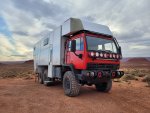We're building up our 1998 M1083, and plan to use a spring-return subframe with a composite box. I was watching a youtube video recently, where a couple stopped and parked their Unimog in high winds. (The Unimog also had a spring-return subframe) The winds were so strong that you could see the habitat rocking back and forth in the wind - similarly to what you'd see a subframe doing while driving on uneven terrain, The couple inside said it was like riding in a boat in rough seas. I started wondering if that rocking motion also occurs while driving in windy conditions. Has anyone experienced that?
Kevin
Yea the subframe is supposed to allow the box to move when the frame twists.
The thing about captured spring is that they WILL impart stress on the box, and the box must be either designed to flex, or deal with this stress and transfer the force into the springs. Think of it like a 3 point mount, attached solid at 2 points on one end, and the third point pivots at the other to allow the frame to twist. Except in the case of a captured spring, that 3rd pivot point shifts between the two frame rails, with the box being lifted up and “pivoting” by whichever frame rail is twisting upward. So the box must be able to deal with being lifted under one frame rail at one end of the box without undue stress or deformation.
At the same time however, as the other frame rail goes down it pulls downward on the box over/above that frame rail thru the springs. And springs doing what they do, this force becomes greater and greater as the frame rail twists down and away.
so in addition to being able to be lifted at one end frame rail location, the box must also withstand the downforce of the springs on the other side…
composite boxes are great, but they tend to be weaker at the seams and corners and do not typically deal with twist very well, which is why a zero torsion 3 or 4 point mount is usually recommended…
i am using captured spring, with a twist, in that I am using hydraulics instead of springs. That way I can tune the force required initially, and maintain a mostly constant force for several inches of travel. IE: more initial force than I could comfortably get out of a spring, but with no increase in force beyond that if I really twist the frame(don't see that happening all that often though). the hydraulics will also allow me to tune the return force to provide some dampening to resist rocking, instead of releasing energy back into the motion as a spring is released.
i am also building the habitat like a ships hull with 1/8X3” ribs and 14ga stressed skin… using the upper frame rail as the floor frame, will give me a 6” tapering to 3” floor, 3” walls and a 3 up to 4” ceiling… projected all up weight will be ~20K pounds which should give me pretty decent balance between the axle weights, which is something you need to pay attention to if running CTIS applying the same pressure to all the tires…


